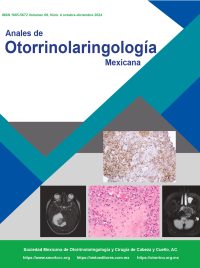Quality of life in older adults with hearing loss before and three months after the fitting of external hearing aid measured with the HHIE-S questionnaire.
An Orl Mex. 2024; 69 (4): 225-236. https://doi.org/10.24245/aorl.v69i4.9646
Paula Weinberger Forische,1 Dina Fabiola González Sánchez,1 Angélica Gómez García,2 Héctor Manuel Prado Calleros1
1 División de Otorrinolaringología y Cirugía de Cabeza y Cuello.
2 Servicio de Audiología, Otoneurología y Foniatría.
Hospital General Dr. Manuel Gea González, Ciudad de México.
Resumen
OBJETIVO: Comparar el puntaje del cuestionario Hearing Handicap Inventory for the Elderly-Screening Version (HHIE-S) de calidad de vida en pacientes adultos mayores con pérdida auditiva, antes y tres meses después de la adaptación de auxiliar auditivo externo.
MATERIALES Y MÉTODOS: Estudio observacional, analítico, longitudinal y prolectivo que incluyó a adultos mayores que acudieron al Hospital General Dr. Manuel Gea González con pérdida auditiva y que eran aptos para la adaptación de auxiliar auditivo. Se les aplicó el cuestionario HHIE-S antes y tres meses después de la adaptación de auxiliar auditivo. Se compararon los resultados obtenidos en el cuestionario y se recolectaron las características clínicas y sociodemográficas, el patrón de uso y lateralidad de los auxiliares auditivos de los pacientes estudiados.
RESULTADOS: Se incluyeron 18 pacientes. Se encontró mejoría significativa de la puntuación total (28.8 vs 9.3), emocional (13.4 vs 4.5) y social (15.4 vs 4.7) antes y tres meses después de la colocación de auxiliar en el cuestionario HHIE-S (p = 0.001). La edad media de los pacientes estudiados fue de 75.5 años y la mayoría eran mujeres. De los 18 pacientes incluidos, 16 tenían diagnóstico de presbiacusia y 9 de diabetes mellitus.
CONCLUSIONES: La colocación de auxiliares auditivos mejora la calidad de vida en los aspectos social y emocional de los adultos mayores con pérdida auditiva, por lo que es de suma importancia identificar y tratar la pérdida auditiva en adultos mayores para repercutir en su calidad de vida.
PALABRAS CLAVE: Hipoacusia; calidad de vida; adultos mayores; auxiliar auditivo.
Abstract
OBJECTIVE: To compare the score of the Hearing Handicap Inventory for the Elderly-Screening Version (HHIE-S) quality of life questionnaire in older adult patients with hearing loss, before and three months after the adaptation of an external hearing aid.
MATERIALS AND METHODS: An observational, analytical, prospective, longitudinal and prolective study including older adults who attended the Dr. Manuel Gea Gonzalez General Hospital, Mexico City, with hearing loss and who were candidates for hearing aid adaptation. The HHIE-S questionnaire was administered before and three months after the hearing aid fitting. The results obtained in the questionnaire were compared and the clinical and sociodemographic characteristics, the pattern of use and laterality of the hearing aids of the patients studied were described.
RESULTS: There were included 18 patients. The results showed a significant improvement in the total score (28.8 vs 9.3), emotional (13.4 vs 4.5) and social (15.4 vs 4.7) before and three months after the placement of the hearing aid in the HHIE-S questionnaire (p = 0.001). The average age of the patients studied was 75.5 years and the majority were women. Most patients had a diagnosis of presbycusis (n = 16) and 9 reported a diagnosis of diabetes mellitus.
CONCLUSIONS: The placement of hearing aids improves the quality of life in the social and emotional aspects of older adults with hearing loss. Therefore, it is of utmost importance to identify and treat hearing loss in older adults to impact the quality of life of these patients.
KEYWORDS: Hearing loss; Quality of life; Aged; Hearing aid.
Recibido: 10 de marzo 2024
Aceptado: 30 de septiembre 2024
Este artículo debe citarse como: Weinberger-Forische P, González-Sánchez DF, Gómez-García A, Prado-Calleros HM. Calidad de vida en adultos mayores con pérdida auditiva antes y tres meses después de la adaptación de auxiliar auditivo externo medida con el cuestionario HHIE-S. An Orl Mex 2024; 69 (4): 225-236.


